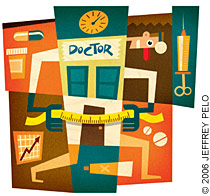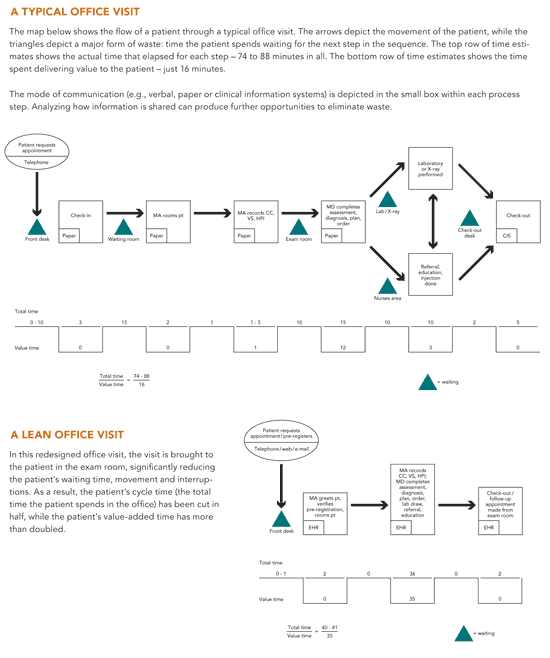
A highly efficient practice is within your reach if you’re willing to examine your processes and ruthlessly eliminate waste.
Fam Pract Manag. 2006;13(4):34-38
Dr. Endsley is medical director of system design for the Health Services Advisory Group in Phoenix. Dr. Magill is professor and chairman of the Department of Family and Preventive Medicine, University of Utah, in Salt Lake City. Marjorie Godfrey is director of clinical practice improvement at Dartmouth-Hitchcock Medical Center in Lebanon, N.H. Author disclosure: nothing to disclose.

Imagine a practice in which your patients get exactly what they want and need exactly when they want and need it. The quality of care you provide is demonstrably high, with no errors, no waiting and no hassles, and your office delivers all of the services recommended for disease management and health maintenance, as well as effective patient education. You and your staff are relaxed, and your office is calm. Your practice is so efficient, with overhead well below the norm, that you make a very comfortable living practicing family medicine. You are always on time for patient visits, and you are always home in time for dinner.
Is this a pipe dream? Not at all. Through initiatives such as the Institute for Healthcare Improvement’s Idealized Design of the Clinical Office Practice1 and Dartmouth-Hitchcock Medical Center’s efforts to understand clinical “microsystems,”2 physicians all across the country are redesigning their practices to meet most or all of the elements described above.3 (See “An example from the real world.”) In addition, the Future of Family Medicine project has issued a call for family physicians to redesign their practices around the “New Model” of family medicine, which is projected to dramatically increase a group’s income.4
So how can you transform your current practice into one that’s more efficient, productive and satisfying to you and your patients? The answer can’t be found in any single technology or strategy, such as electronic health records or advanced-access scheduling. Although useful, these tools are not inherently valuable in themselves.
Instead, surprisingly, the answer comes from the automobile industry. Lean design, or lean thinking,5 is the term used to describe the radical improvement in manufacturing that Toyota developed decades ago to build ever-better automobiles at ever-lower costs. Lean design is now being incorporated into a wide range of industries, including service industries, such as health care.6,7 Very simply, it is about simplifying processes by understanding what adds value and eliminating waste. For family physicians, this means seeing your practice as a system of processes, knowing what value your patients derive from your practice and eliminating steps or tasks that do not meet the needs of your patients.
AN EXAMPLE FROM THE REAL WORLD
Charles Burger, MD, has integrated lean design methods into the quality improvement work at Norumbega Medical Specialists in Bangor, Maine. For instance, his front-office staff had been reporting a high volume of calls from patients who said they had not received their test results. A patient satisfaction survey also suggested that his patients were unhappy with the process of getting laboratory test results. With the help of his administrative and clinical quality improvement teams, he mapped the practice’s process for managing laboratory test results and began looking for ways to improve it. The process was redesigned through elimination of several non-value-added steps and redirecting test results through direct, secure e-mail to patients through a Web-enabled system (Kryptiq) triggered within his electronic health record. He monitored the timeliness and accuracy of this redesigned process through daily audits. Overall, his patient satisfaction with test results management increased from 89 percent to 97 percent. Further, he has been able to decrease his results reporting error rate from 3 percent to nearly 0 percent.
Understanding what your patients value
In lean design, every step within every process within your practice – from the check-in process to the rooming process to the refill process – should add value for your customers: your patients. Of course, some steps or processes may not be directly valuable to patients but may be essential to operating your business. The point is simply to make the patient’s experience as value-added as possible. When you create a value-added experience for the patient, something unexpected occurs: you end up more satisfied yourself, with a more efficient, effective practice.
To understand what is truly important to your patients, consider several ways of collecting their views.
The most obvious way to gain knowledge about what your patients want or need from your practice is simply to ask them. The “Primary Care Practice Patient Viewpoint Survey,” available as part of the Assessing, Diagnosing and Treating Your Outpatient Primary Care Practice workbook from the Dartmouth-Hitchcock Medical Center,8 is a helpful tool. You could also conduct focus groups or open-ended interviews with patients to elicit their opinions.
Mock patient visits can also be enlightening. To do this, call your practice just as a patient would and schedule a visit for yourself. Then, follow the patient process from registration to discharge, and record your observations, surprises and frustrations. (Again, see the Dartmouth workbook8 and turn to the “Through the Eyes of Your Patients” worksheet for help in conducting a walk-through.)
A final strategy is simply observing the care process. By stepping back from your normal role and observing how work is carried out in your practice, you can gain some astonishing insights. A useful tool to guide observation is the “Gaining Customer Knowledge” worksheet, found at http://cms.dartmouth.edu/images/PDF%20Files/GainCustKnowWrksht.pdf.
Regardless of which strategy you employ, you’ll find that every patient has unique values; however, there are a number of common themes. Studies from the Picker Institute9 have identified eight dimensions of patient-centered care: 1) respect for their values, preferences and needs, 2) information, communication and education, 3) access to care, 4) emotional support, 5) involvement of family and friends, 6) continuity of care and seamless transitions, 7) physical comfort and 8) coordination and integration of care.
The Picker Institute offers an online program (http://nrcpicker.com/Default.aspx?DN=232,227,3,1,Documents) that walks you through an assessment of your practice based on these eight dimensions and offers recommendations for improving in each area.
Cleaning up your processes
Once you understand what your patients want and need from your practice, you can select one aspect of care delivery (e.g., diabetes visits, prescription refills or preventive services) that you will focus on first. The process you select should be based on your assessment of patients’ needs. Identify who will be involved in improving the process and how you intend to go about it. A key tenet of lean design is that those who do the work should design the work based on a deep knowledge of patients’ needs.
Now, you can begin to examine your processes, also called “value streams,” with the goal of eliminating any steps that do not add value. Here’s how:
First, map the current state. Determine the start and end points of the process from the patient perspective, and begin to map all the main steps in between. To get an accurate picture of the current process, you may actually need to walk the process, considering how, when and where people move during the process, who the customers and suppliers are, how information is recorded and exchanged, how technology is applied, how steps in the process are sequenced, what triggers the work, and how much time is spent at each step and for the entire process, including waiting time.10 Stay focused on high-level steps and focus on the usual process, not on the exceptions.
A map of a typical patient visit is shown below. You can also download a mapping worksheet developed by one of the co-authors (Godfrey) .

Click below to download a mapping worksheet developed by one of the co-authors (Godfrey).
Second, identify waste. Looking at your map of the current process, identify any flow problems or any steps that do not bring value to patients. This is the waste in your process. Lean design identifies seven categories of waste, which can be applied to the practice setting:
Overproduction involves completing any work that isn’t needed right now, such as prescribing antibiotics for a viral infection.
Motion refers to any unnecessary movement of patients, staff or physicians.
Material movement refers to any unnecessary transfers of materials or information, such as the hand-off of patient intake forms from the front office to the back office to the physician.
Waiting refers to any delays or idle time involving the patient, physician or staff, such as patients waiting for an exam room to be readied or staff waiting for a report to be faxed.
Inventory involves any information or materials waiting to be used, such as a stack of unread laboratory reports or piles of patient booklets sitting in the waiting area.
Inappropriate processing refers to handling work in a way that is excessive, such as completing all paperwork in triplicate or scheduling separate visits for acute care and wellness care when one visit would suffice.
Rework involves any unnecessary work required because of an error, such as sending the patient back to the laboratory because a lab order was incomplete.
The table provides more examples of common problems in medical practices.
Third, map the future state. Re-map your process, building in the changes that you believe will eliminate any waste problems and maximize value. Some design features to consider in rebuilding the process include the following:11
Don’t move the patient. Instead, where it makes sense, make the work come to the patient.
Eliminate needless work. Perhaps your process includes too many handoffs or outdated steps you’re completing out of routine.
Increase clinician support. Because face-to-face time with the doctor is often the most valuable part of the visit, do everything you can to make the physician more effective.
Make sure your process involves direct communication between parties.
Consider whether technology can play a role in improving your process.
Create broad work roles so your staff can complete their work more efficiently and reduce the number of handoffs required.
The figure shows a visit redesigned to be lean.
Fourth, test and revise the new process. With the map of your redesigned process in hand, set a plan for testing it. Identify how you will test the change, who will be involved, how long the test will last, and how you will measure whether the change works. There are a number of excellent resources for using the plan-do-study-act cycle for rapidly testing and implementing change.12,13
Once you implement the new process, your work isn’t finished. Achieving a lean process of care delivery requires continuous innovation and improvement. The goal should be nothing short of the pursuit of perfection. This will require that you continuously measure key aspects of the new process, map the process regularly to ensure it is still effective, and empower your staff to develop and test new designs of care.
| Output problems | Examples |
|---|---|
| Following the wrong process | Ordering the wrong lab test |
| Following the process incorrectly | Doing a purified protein derivative test subcutaneously |
| Over-producing tasks that do not add value | Ordering multiple referrals for the same problem |
| Delaying a process | Ordering a mammogram after a breast mass has been palpated |
| Variation in output rate or quality | Processing referrals in one batch rather than steadily |
| Wide variations in demand | Seeing increased flu cases in the winter |
Achieving the vision
Achieving the full vision of the New Model of family medicine will require more than a patchwork adoption of new strategies such as same-day scheduling, electronic health records, group visits and staff cross-training. It will require understanding the importance of systems within your practice and incorporating lean design. When combined with the “basket of services” described in the New Model, lean design could reinvigorate the practice of family medicine.